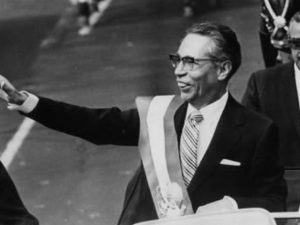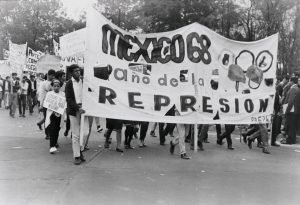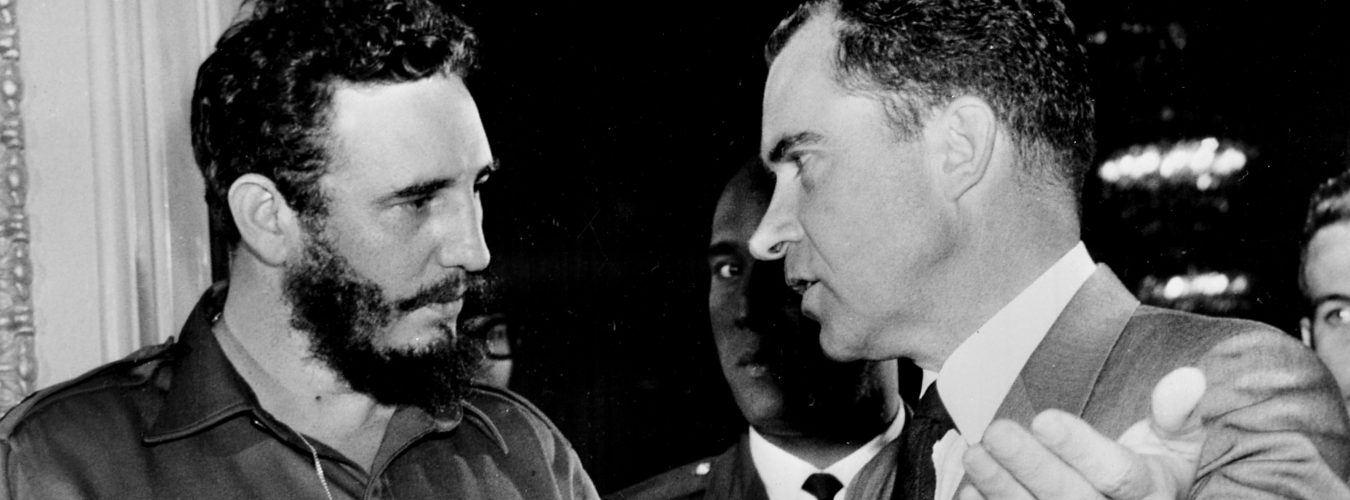
Figure 1: President Gustavo Diaz Ordaz, elected in 1964
Gustavo Diaz Ordaz, a member of Mexico’s reigning PRI party, began his presidency with high prospects. Mexicans expected someone who would continue their economic boom and put Mexico on an international stage. However, Ordaz’s presidency quickly became one of the rule of force and violence, leading to massacres and suppression of the Mexican people. With U.S. backing and an anti-communist stance, Ordaz finished his term as president and was succeeded by another PRI party member. The party was able to remain in charge for three more decades.
The 1960s marked the beginning of the era of tumult for Mexico. While the United States and the Soviet Union contended with the Cold War, there were other countries that had to deal with unrest as well. In 1960, the Soviet Academy of Sciences Institute of Latin America published a report that detailed observations from a Soviet Exhibition in Mexico the year prior. In initial reports, members of the Institute outlined prospects for the future of both countries and potential cooperation. Four years later, the same Institute wrote a complete summary of Mexico and its geopolitical space, which laid out the structure of Mexican society and ways that the Soviets could find sympathy among the masses. The report’s timing also coincided with an upcoming general election for the presidency at the end of that year, something that the Soviets recognized in their observations. They even outlined which candidates were likely to be sympathetic to the USSR and which candidates were more likely to side with the United States. Reports from the Soviet Institue of Latin America recognized that Gustavo Diaz Ordaz was the leading candidate at the time of the report and recognized his stance as a staunch anti-Communist. They believed he had more authoritarian tendencies and would likely win due to the PRI’s backing from his party. As such the Soviet government was warned to be wary of Ordaz and his policies leading into the elections. did.
In the July 1964 national elections, Mexico voted in the candidate for the Institutional Revolutionary Party (PRI), Gustavo Diaz Ordaz. Ordaz and his party won an overwhelming 93% of the vote, with every state in Mexico and their capital voting for them. With the PRI retaining overwhelming control of the government, Ordaz went on to fulfill many of the goals the PRI had for Mexico. Some of the changes seen in the country included establishing the oil industry in Mexico and taking advantage of a robust economic boom. However, Ordaz was also regularly active in foreign affairs. Throughout most of his presidency, Ordaz had a positive relationship with the United States. The PRI party historically had a good relationship with the United States, and their anti-communist ideals made them a prime group for United States support. In 1968, however, the United States’ support would help launch a bloody culture war in Mexico.

In the late 1960s, many students across Mexico had begun to show support for more leftist ideals and social changes, especially after the 1968 Olympics in Mexico City that led the government to pour money into the Olympics’ facilities, ignoring the needs of the populace. Some of the demands made by students in 1968 were that the government give more civil liberties for people, democratize the government more and that members of the PRI party begin resigning, as the party had led the country for over 40 years. Ordaz, nearing the end of his presidency in 1968, commanded government forces, backed by the CIA, to quell many of the protests, sometimes with violent results. The most well-known of these events was the Tlatelolco Massacre on October 2, 1968. Even now, any of the details about the massacre are still unknown, but what is known is government forces composed of the Mexican military and multiple police forces opened fire on a group of nearly 10,000 students protesting in the city of Tlatelolco. Events like this took place throughout the latter half of the 20th century in Mexico. The PRI attempted to quell any form of dissent, leading to an authoritarian-like rule that lasted until 2000.
The massacre does not go unnoticed. A day after the event, the New York Times publishes a story detailing the events of the massacre, writing, “A thousand federal soldiers fired rifles and machine guns at what had been a peaceful student rally in the plaza of a housing project last night.” In 1990, Mario Llosa, a Peruvian writer, would call the government under the PRI “the perfect dictatorship,” as it was an authoritarian government that performed the same violations as any dictatorship, but it gave the perception of free elections and people.
References
Montgomery, Paul L. “Deaths Put at 49 In Mexican Clash,”New York Times. Oct 4, 1968 Pg. 1
“Diaz Is Said to Win Easily in Mexico,”.New York Times, July 7, 1964, Page 12
Nikiforov, B.S. Mexico: Politics, Ideology, and the Economy. Moscow: Russian Academy of Sciences, 1964
Soviet Academy of Sciences, . Soviet Report, ‘Mexico: Economic Situation and Prospects of Development of Economic Ties with the Soviet Union, 1960 Moscow: Cold War International History Project
